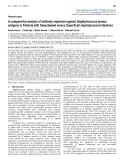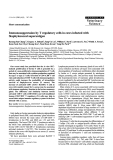
Staphylococcal infections
-
Tuyển tập các báo cáo nghiên cứu khoa học ngành y học tạp chí Medical Sciences dành cho các bạn sinh viên ngành y tham khảo đề tài: A comparative analysis of antibody repertoire against Staphylococcus aureus antigens in Patients with Deep-Seated versus Superficial staphylococcal Infections...
 8p
8p  thulanh9
thulanh9
 07-10-2011
07-10-2011
 40
40
 3
3
 Download
Download
-
Tuyển tập các báo cáo nghiên cứu khoa học quốc tế về bệnh thú y đề tài: Immunosuppression by T regulatory cells in cows infected with Staphylococcal superantigen
 4p
4p  hoami_266
hoami_266
 16-09-2011
16-09-2011
 31
31
 2
2
 Download
Download
-
Antimicrobial Therapy for Selected Settings For uncomplicated skin and soft tissue infections, the use of oral antistaphylococcal agents is usually successful. For other infections, parenteral therapy is indicated. S. aureus endocarditis is usually an acute, life-threatening infection. Thus prompt collection of blood for cultures must be followed immediately by empirical antimicrobial therapy. For S. aureus native-valve endocarditis, a combination of antimicrobial agents is often used.
 7p
7p  colgate_colgate
colgate_colgate
 21-12-2010
21-12-2010
 62
62
 3
3
 Download
Download
-
As a result of the widespread dissemination of plasmids containing the enzyme penicillinase, few strains of staphylococci (
 6p
6p  colgate_colgate
colgate_colgate
 21-12-2010
21-12-2010
 65
65
 2
2
 Download
Download
-
Diagnosis While the detection of CoNS at sites of infection or in the bloodstream is not difficult by standard microbiologic culture methods, interpretation of these results is frequently problematic. Since these organisms are present in large numbers on the skin, they often contaminate cultures. It has been estimated that only 10–25% of blood cultures positive for CoNS reflect true bacteremia. Similar problems arise with cultures of other sites. Among the clinical findings suggestive of true bacteremia are fever, evidence of local infection (e.g.
 4p
4p  colgate_colgate
colgate_colgate
 21-12-2010
21-12-2010
 60
60
 4
4
 Download
Download
-
Table 129-3 Antimicrobial Therapy for Serious Staphylococcal Infectionsa Sensitivity/Resis tance of Isolate Drug of Choice s) Alternative( Comments Sensitive penicillin to Penicilli Nafcillin (2 Fewer than n G (4 mU q4h) g q4h) or oxacillin 5% of isolates are (2 g q4h), cefazolin sensitive (2 g q8h), penicillin.
 8p
8p  colgate_colgate
colgate_colgate
 21-12-2010
21-12-2010
 66
66
 3
3
 Download
Download
-
Food Poisoning S. aureus is among the most common causes of food-borne outbreaks of infection in the United States. S. aureus food poisoning results from the inoculation of toxin-producing S. aureus into food by colonized food handlers. Toxin is then elaborated in such growth-promoting food as custards, potato salad, or processed meats. Even if the bacteria are killed by warming, the heat-stable toxin is not destroyed. The onset of illness is rapid, occurring within 1–6 h of ingestion.
 5p
5p  colgate_colgate
colgate_colgate
 21-12-2010
21-12-2010
 69
69
 4
4
 Download
Download
-
Skin and Soft Tissue Infections S. aureus causes a variety of cutaneous infections. Common predisposing factors include skin disease, skin damage (e.g., insect bites, minor trauma), injections (e.g., in diabetes, injection drug use), and poor personal hygiene. These infections are characterized by the formation of pus-containing blisters, which often begin in hair follicles and spread to adjoining tissues. Folliculitis is a superficial infection that involves the hair follicle, with a central area of purulence (pus) surrounded by induration and erythema.
 6p
6p  colgate_colgate
colgate_colgate
 21-12-2010
21-12-2010
 630
630
 3
3
 Download
Download
-
Respiratory Tract Infections Respiratory tract infections caused by S. aureus occur in selected clinical settings. S. aureus is a cause of serious infections in newborns and infants; these infections present as shortness of breath, fever, and respiratory failure. Chest x-ray may reveal pneumatoceles (shaggy, thin-walled cavities). Pneumothorax and empyema are recognized complications of this infection. In adults, nosocomial S. aureus pulmonary infections are commonly seen in intubated patients in intensive care units.
 5p
5p  colgate_colgate
colgate_colgate
 21-12-2010
21-12-2010
 76
76
 3
3
 Download
Download
-
Urinary Tract Infections Urinary tract infections (UTIs) are infrequently caused by S. aureus. In contrast with that of most other urinary pathogens, the presence of S. aureus in the urine suggests hematogenous dissemination. Ascending S. aureus infections occasionally result from instrumentation of the genitourinary tract. Prosthetic Device–Related Infections S. aureus accounts for a large proportion of prosthetic device–related infections.
 6p
6p  colgate_colgate
colgate_colgate
 21-12-2010
21-12-2010
 73
73
 3
3
 Download
Download
-
Evasion of Host Defense Mechanisms Evasion of host defense mechanisms is critical to invasion. Staphylococci possess an antiphagocytic polysaccharide microcapsule. Most human S. aureus infections are due to capsular types 5 and 8. The S. aureus capsule also plays a role in the induction of abscess formation. The capsular polysaccharides are characterized by a zwitterionic charge pattern (the presence of both negatively and positively charged molecules) that is critical to abscess formation. Protein A, an MSCRAMM unique to S. aureus, acts as an Fc receptor.
 5p
5p  colgate_colgate
colgate_colgate
 21-12-2010
21-12-2010
 77
77
 3
3
 Download
Download
-
Exfoliative Toxins and the Staphylococcal Scalded-Skin Syndrome The exfoliative toxins are responsible for SSSS. The toxins that produce disease in humans are of two serotypes: ETA and ETB. These toxins disrupt the desmosomes that link adjoining cells. Although the mechanism of this disruption remains uncertain, studies suggest that the toxins possess serine protease activity, which—through undefined mechanisms—triggers exfoliation.
 5p
5p  colgate_colgate
colgate_colgate
 21-12-2010
21-12-2010
 53
53
 2
2
 Download
Download
-
Regulation of Virulence Gene Expression In both toxin-mediated and non-toxin-mediated diseases due to S. aureus, the expression of virulence determinants associated with infection depends on a series of regulatory genes [e.g., accessory gene regulator (agr) and staphylococcal accessory regulator (sar)] that coordinately control the expression of many virulence genes. The regulatory gene agr is part of a quorum-sensing signal transduction pathway that senses and responds to bacterial density.
 4p
4p  colgate_colgate
colgate_colgate
 21-12-2010
21-12-2010
 59
59
 2
2
 Download
Download
-
Harrison's Internal Medicine Chapter 129. Staphylococcal Infections Staphylococcal Infections: Introduction Staphylococcus aureus, the most virulent of the many staphylococcal species, has demonstrated its versatility by remaining a major cause of morbidity and mortality despite the availability of numerous effective antistaphylococcal antibiotics. S. aureus is a pluripotent pathogen, causing disease through both toxin-mediated and non-toxin-mediated mechanisms.
 5p
5p  colgate_colgate
colgate_colgate
 21-12-2010
21-12-2010
 86
86
 3
3
 Download
Download
-
S. aureus Infections Epidemiology S. aureus is a part of the normal human flora; ~25–50% of healthy persons may be persistently or transiently colonized. The rate of colonization is higher among insulin-dependent diabetics, HIV-infected patients, patients undergoing hemodialysis, and individuals with skin damage. The anterior nares are the most frequent site of human colonization, although the skin (especially when damaged), vagina, axilla, perineum, and oropharynx may also be colonized.
 5p
5p  colgate_colgate
colgate_colgate
 21-12-2010
21-12-2010
 81
81
 2
2
 Download
Download
-
Rifampin Bacteria rapidly become resistant to rifampin by developing mutations in the B subunit of RNA polymerase that render the enzyme unable to bind the antibiotic. The rapid selection of resistant mutants is the major limitation to the use of this antibiotic against otherwise-susceptible staphylococci and requires that the drug be used in combination with another antistaphylococcal agent. Linezolid Enterococci, streptococci, and staphylococci become resistant to linezolid in vitro by mutation of the 23S rRNA binding site. Clinical isolates of E. faecium and E.
 5p
5p  colgate_colgate
colgate_colgate
 21-12-2010
21-12-2010
 69
69
 3
3
 Download
Download
-
More common than tunnel infections are exit-site infections, often with erythema around the area where the line penetrates the skin. Most authorities (Chap. 129) recommend treatment (usually with vancomycin) for an exit-site infection caused by a coagulase-negative Staphylococcus. Treatment of coagulasepositive staphylococcal infection is associated with a poorer outcome, and it is advisable to remove the catheter if possible. Similarly, many clinicians remove catheters associated with infections due to P.
 5p
5p  konheokonmummim
konheokonmummim
 03-12-2010
03-12-2010
 81
81
 5
5
 Download
Download
-
Table 54-12 Causes of Vesicles/Bullae I. Primary cutaneous diseases A. Primary blistering diseases (autoimmune) 1. Pemphigusa 2. Bullous pemphigoidb 3. Gestational pemphigoidb 4. Cicatricial pemphigoidb 5. Dermatitis herpetiformisb,c 6. Linear IgA bullous dermatosisb 7. Epidermolysis bullosa acquisitab,d B. Secondary blistering diseases 1. Contact dermatitisa 2. Erythema multiformea,b 3. Stevens-Johnson syndrome 4. Toxic epidermal necrolysisb C. Infections 1. Varicella/zoster virusa,e 2. Herpes simplex virusa,e 3. Enteroviruses, e.g., hand-foot-and-mouth disease 4.
 6p
6p  konheokonmummim
konheokonmummim
 30-11-2010
30-11-2010
 77
77
 7
7
 Download
Download
CHỦ ĐỀ BẠN MUỐN TÌM






























